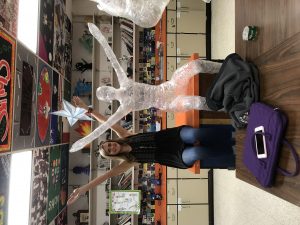Addie's Blog
Just another Wonecks.net Blogs site
Pixels- a minute area of illumination on a display screen, one of many from which an image is composed
Image resolution- a minute area of illumination on a display screen, one of many from which an image is composed
Megabyte- a minute area of illumination on a display screen, one of many from which an image is composed
Megapixel – a unit of graphic resolution equivalent to one million or (strictly) 1,048,576 (220) pixels.
Gigabyte- a unit of information equal to one billion (109) or, strictly, 230 bytes.
jpeg- a format for compressing image files.
Raw- a file that contains minimally processed data from theimage sensor of either a digital camera, image scanner, or motion picture film scanner.
Tiff- The ability to store image data in a lossless format makes a TIFF file a useful image archive, because, unlike standard JPEG files, a TIFF file using lossless compression (or none) may be edited and re-saved without losing image quality. This is not the case when using the TIFF as a container holding compressed JPEG.
PNG- (pronounced ping as in ping-pong; for Portable Network Graphics) is a file format for image compression that, in time, is expected to replace the Graphics Interchange Format (GIF) that is widely used on today’s Internet.
Histogram- is a graphical representation of the distribution of numerical data. It is an estimate of the probability distribution of a continuous variable.
Aperture- a hole or an opening through which light travels.
Shutter speed- the length of time when the film or digital sensor inside the camera is exposed to light, also when a camera’s shutter is open when taking a photograph. The amount of light that reaches the film or image sensor is proportional to the exposure time.
Depth of field- the amount of distance between the nearest and farthest objects that appear in acceptably sharp focus in a photograph.
Noise- The occurrence of color dots or specks where there should be none.
Lag time- Refers to latency, or lag measured by the difference between the time there is a signal input, and the time it takes the input to display on the screen.
Hot shoe- A mounting point on the top of a camera to attach a flash unit and other compatible accessories.
Fisheye- A lens of small focal length, having a highly curved protruding front element, that covers an angle of view of almost 180°.
Aperture priority- a setting on some cameras that allows the user to choose a specific aperture value while the camera selects a shutter speed to match, thereby ensuring proper exposure
Shutter priority- a setting on some cameras that allows the user to choose a specific shutter speed while the camera adjusts the aperture to ensure correct exposure.
Bitmap- mapping from some domain (for example, a range of integers) to bits, that is, values which are zero or one. It is also called a bit array or bitmap index.
White balance- the process of removing unrealistic color casts, so that objects which appear white in person are rendered white in your photo.
Exposure-the act of exposing, laying open, or uncovering:
Watermarking- a kind of marker covertly embedded in a noise-tolerant signal such as an audio, video or image data. It is typically used to identify ownership of the copyright of such signal.
Optical Zoom- allows you to zoom in (or out) on the subject in the LCD or viewfinder. This will enable you to get a closer view of the subject before taking your picture.
Macro- a lens suitable for taking photographs unusually close to the subject.
Telephoto- a lens with a longer focal length than standard, giving a narrow field of view and a magnified image.
Wide Angle- (of a lens) having a short focal length and hence a field covering a wide angle.
DSLR- A digital single-lens reflex camera (also called a digital SLR or DSLR) is a digital camera combining the optics and the mechanisms of a single-lens reflex camera with a digital imaging sensor, as opposed to photographic film.
Digital zoom- is a function of a digital camera used to make the image seem more close-up.Digital Zoom on a digital camera works the same as cropping and enlarging a photo in a graphics program.
Bracketing- place (one or more people or things) in the same category or group.
Light meter- an instrument for measuring the intensity of light, used chiefly to show the correct exposure when taking a photograph.
Image stabilization- (IS) is a family of techniques used to reduce blurring associated with the motion of a camera or other imaging device during exposure.
Dynamic range- is the difference between the smallest and largest usable signal through a transmission or processing chain or storage medium. It is measured as a ratio, or as a base-10 (decibel) or base-2 (doublings, bits or stops) logarithmic value.
Digital negative- (DNG) is an open lossless raw image format written by Adobe used for digital photography. It was launched on September 27, 2004.
Exposure compensation- Exposure compensation is a technique for adjusting the exposure indicated by a photographic exposure meter, in consideration of factors that may cause the indicated exposure to result in a less-than-optimal image
Topic: Fan Wakes up from coma and watches Roger Federer
Title: Roger Federer Fan Wakes from 11-Year Coma to Watch Idol in US Open Final
Article Source: http://bleacherreport.com/articles/2570520-roger-federer-fan-wakes-from-11-year-coma-to-watch-idol-in-us-open-final?utm_source=cnn.com&utm_medium=referral&utm_campaign=editorial
Summary: Jesus Aparicio was in a car crash and was in a coma for 11 years. He was a big Roger Federer fan. When he went into the coma Roger Federer was 23rd with only 4 grand slam titles. Aparicio woke up on August 27 this year and Federer was one of the first things he remembered. Aparicio thought that Federer had retired, and when he found the news that he hadn’t he turned him on and watched the final match of the US open on September 13. Federer is now number 2 and has won 17 grand slam titles. Aparicio was surprised to see him play well but glad to watch him.
Reaction: I thought it was pretty cool that he was in a coma for 11 years and suddenly woke up and wanted to watch Roger Federer play tennis. I thought it was pretty crazy that he remembered him so quickly after he woke up. Federer has improved so much during the 11 years Aparicio was in the coma and I think it’s cool that his fan can watch him again. It’s also amazing that he woke up after being in a coma for 11 long years. This made me happy.
How it affects the world: This doesn’t affect the world much but it shows that people can wake up from comas and remember some of their favorite things. It also gives hope to families that have loved ones still in comas, that there is a chance that they would wake up and live a normal life.
Topic: Boy builds clock but it is suspected to be a bomb.
Title: Student builds clock, is Cuffed For Bomb Hoax, and Ends Up Invited To The White House
Source: Student Builds Clock, Is Cuffed for Bomb Hoax, and Ends Up Invited to White House – The New York Times
https://apple.news/A-3U4tG8aSpykk6jelYtgiQ
Summary: Boy in Irving Texas builds a clock that was suspected to be a bomb. Ahmed Mohamed, 14, a freshman at MacArthur High School was not charged with anything. Some suspect that he was questioned about the clock because of his religion. President Obama invited Ahmed to the White House to show him his clock. Ahmed will be going to the White House in October to show his clock to President Obama.
Reaction: My first reaction was, “How did they think a clock was a bomb?” Until I saw the picture. It honestly does look like a bomb, and it’s probably a good thing the authorities checked him out. Although I do think he should have been able to contact his parents while in the police station. I think this was sort of an overreaction, but also necessary in some ways. The poor kid just wanted to show off his invention, but got accused of something ridiculous. If it had been a bomb though, the authorities would’ve needed to take it up.
How it affects the world: This affects the world by showing how crazy people can think and how fast someone can assume something that isn’t true. It shows however that people are ready to act on danger as fast as they can which is a good thing. This shows us that we are somewhat paranoid and always on the lookout for things like this. The authorities don’t need to be so quick to arrest someone unless there is a serious threat. I am glad though that they were prepared and ready for a bomb, if it was one.
Topic: Girl is said to be smarter than Albert Einstein.
Title: British 12-Year-old smarter than Einstein, Hawking
Article Source: http://www.cnn.com/2015/09/09/europe/mensa-british-girl-score/index.html
Summary: A british 12 year old girl named Lydia Sebastian achieved a top score of 162 on Mensa’s Cattel III B paper which suggests she has a higher IQ than Einstein. The top score on the test before Lydia was 161. Lydia is in the top 2% score. This score put her in the top 1% of the world. People on average with high IQs only score about 148.
Reaction: My reaction was, “ Wow this girl is smart.” To be a twelve year old that is smarter than Einstein blew my mind. Also scoring in the top 1% of the world is fantastic. Overall my reaction was shock and amazement. I thought it was awesome how a 12 year old was so smart.
How it affects the world: As she grows and becomes more intelligent she could create groundbreaking ideas. She could become the smartest individual ever and invent many amazing things. She might be able to come up with cures for diseases or other things. This affects the world by showing us that an intelligent girl is coming and could do great things.
Topic: Obama changes the name of Mt. McKinley.
Title: Obama to rename tallest U.S. peak in historic Alaska visit
Article source: cnn.com
Summary: President Obama decided to change the name of the tallest mountain, Mt McKinley to Denali because native alaskans have wanted it to be changed. Obama’s visit to Alaska is also historic because he will be the first sitting U.S. president to visit the arctic. The park around the mountain was originally named Denali but the Mountain itself was still called McKinley till now. Obama will also address the climate changes that Alaska is facing and offer solutions for them. Later this year he will address the problem of global warming.
Reaction: I’m not exactly sure why Obama changed the name of the mountain, or why it was necessary. I know the natives to that area used to call it that, but it was already named. Him trying to solve the problem of Global Warming is good. It is also good that he is visiting Alaska, and trying to please the people, but it’s been named Mt. McKinley for a while. So my reaction was wondering why he changed the name.
How it affects the world: This affects the world by people having to change what they know. They have to change the highest mountain in the U.S, that they know as McKinley, to Denali. If Obama can help prevent Global warming in his upcoming studies, that can help the world and especially Alaska. Overall this name change affects the history of Alaska.
http://www.cnn.com/2015/08/30/politics/obama-alaska-denali-climate-change/index.html
© 2025 Addie's Blog
Theme by Anders Noren — Up ↑




Recent Comments